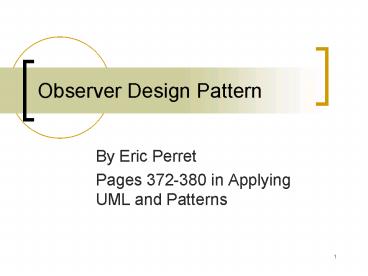Observer Design Pattern - PowerPoint PPT Presentation
Title:
Observer Design Pattern
Description:
... (the publisher) and the object that needs a change notification (the subscriber) ... about subscribers only through an interface and subscribers can ... – PowerPoint PPT presentation
Number of Views:61
Avg rating:3.0/5.0
Title: Observer Design Pattern
1
Observer Design Pattern
- By Eric Perret
- Pages 372-380 in Applying UML and Patterns
2
What we are covering.
- Definition
- Example
- Example using code
- Why it is a good idea to use the pattern.
- Summary
3
What is an Observer?
- The Observer design pattern, or more accurately
some implementation of this pattern, is used to
assure consistency between different objects. - AKA Publish-Subscribe
4
What does this really mean.
- When an object changes state, all of the objects
that need to know about it are notified and
updated automatically.
5
Example
- Let the state of an object "B" depend on the
state of an object "A". Whenever the state of
object "A" changes, "B" has to recompute its
state in order to remain consistent with "A". - The observer design pattern supports such
dependencies and at the same time tries to reduce
the coupling between the object that changes (the
publisher) and the object that needs a change
notification (the subscriber).
6
Here's an example of the interfaces in java-like
code
- public abstract interface Subject public
abstract void addObserver(Observer
observer) public abstract void
removeObserver(Observer observer) public
abstract void notify()public abstract class
Observer public abstract void update()
- The subject calls its "notify" operation whenever
it changes. "Notify" calls the "update" operation
on each observer. The observers then call back to
the subject and update themselves accordingly.
7
Why Use the Pattern?
- State dependencies between objects are
unfavorable for several reasons. - If we could model our problem domain as a set of
independent classes, we would get a software
system without state dependencies. - Coding and especially maintaining such a system
would be much easier. The programmer could focus
on single classes only.
8
Summary
- Loosely couple objects in terms of communication
- Publishers know about subscribers only through an
interface and subscribers can register or
de-register dynamically with the publisher
9
Question, comments, theories, or conundrums?
- Slides can be found here http//www.rpi.edu/perr
ee/sdd
10
References
- Applying UML and Patterns by Craig Larman,
352-380 - On Using the Observer Design Pattern by
Constantin Szallies, http//www.wohnklo.de/pattern
s/observer.html - Observer Design Pattern by Stephen Lam,
http//sern.ucalgary.ca/courses/SENG/609.04/W98/la
msh/observerLib.html

